The Intel Haswell-E CPU Review: Core i7-5960X, i7-5930K and i7-5820K Tested
by Ian Cutress on August 29, 2014 12:00 PM ESTEvolution in Performance
The underlying architecture in Haswell-E is not anything new. Haswell desktop processors were first released in July 2013 to replace Ivy Bridge, and at the time we stated an expected 3-17% increase, especially in floating point heavy benchmarks. Users moving from Sandy Bridge should expect a ~20% increase all around, with Nehalem users in the 40% range. Due to the extreme systems only needing more cores, we could assume that the suggested recommendations for Haswell-E over IVB-E and the others were similar but we tested afresh for this review in order to test those assumptions.
For our test, we took our previous CPU review samples from as far back as Nehalem. This means the i7-990X, i7-3960X, i7-4960X and the Haswell-E i7-5960X.
Each of the processors were set to 3.2 GHz on all the cores, and set to four cores without HyperThreading enabled.
Memory was set to the CPU supported frequency at JEDEC settings, meaning that if there should Intel have significantly adjusted the performance between the memory controllers of these platforms, this would show as well. For detailed explanations of these tests, refer to our main results section in this review.
Average results show an average 17% jump from Nehalem to SNB-E, 7% for SNB-E to IVB-E, and a final 6% from IVB-E to Haswell-E. This makes for a 31% (rounded) overall stretch in three generations.
Web benchmarks have to struggle with the domain and HTML 5 offers some way to help use as many cores in the system as possible. The biggest jump was in SunSpider, although overall there is a 34% jump from Nehalem to Haswell-E here. This is split by 14% Nehalem to SNB-E, 6% SNB-E to IVB-E and 12% from IVB-E to Haswell-E.
Purchasing managers often look to the PCMark and SYSmark data to clarify decisions and the important number here is that Haswell-E took a 7% average jump in scores over Ivy Bridge-E. This translates to a 24% jump since Nehalem.
Some of the more common synthetic benchmarks in multithreaded mode showed an average 8% jump from Ivy Bridge-E, with a 29% jump overall. Nehalem to Sandy Bridge-E was a bigger single jump, giving 14% average.
In the single threaded tests, a smaller overall 23% improvement was seen from the i7-990X, with 6% in this final generation.
The take home message, if there was one, from these results is that:
Haswell-E has an 8% improvement in performance over Ivy Bridge-E clock for clock for pure CPU based workloads.
This also means an overall 13% jump from Sandy Bridge-E to Haswell-E.
From Nehalem, we have a total 28% raise in clock-for-clock performance.
Looking at gaming workloads, the difference shrinks. Unfortunately our Nehalem system decided to stop working while taking this data, but we can still see some generational improvements. First up, a GTX 770 at 1080p Max settings:
The only title that gets much improvement is F1 2013 which uses the EGO engine and is most amenable to better hardware under the hood. The rise in minimum frame rates is quite impressive.
For SLI performance:
All of our titles except Tomb Raider get at least a small improvement in our clock-for-clock testing with this time Bioshock also getting in on the action in both average and minimum frame rates.
If we were to go on clock-for-clock testing alone, these numbers do not particularly show a benefit from upgrading from a Sandy Bridge system, except in F1 2013. However our numbers later in the review for stock and overclocked speeds might change that.
Memory Latency and CPU Architecture
Haswell is a tock, meaning the second crack at 22nm. Anand went for a deep dive into the details previously, but in brief Haswell bought better branch prediction, two new execution ports and increased buffers to feed an increased parallel set of execution resources. Haswell adds support for AVX2 which includes an FMA operation to increase floating point performance. As a result, Intel doubled the L1 cache bandwidth. While TSX was part of the instruction set as well, this has since been disabled due to a fundamental silicon flaw and will not be fixed in this generation.
The increase in L3 cache sizes for the highest CPU comes from an increased core count, extending the lower latency portion of the L3 to larger data accesses. The move to DDR4 2133 C15 would seem to have latency benefits over previous DDR3-1866 and DDR3-1600 implementations as well.


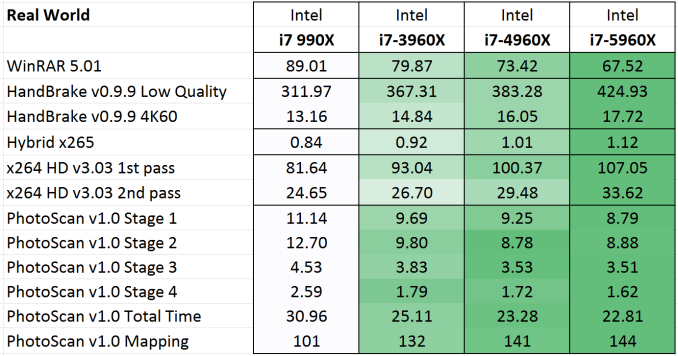


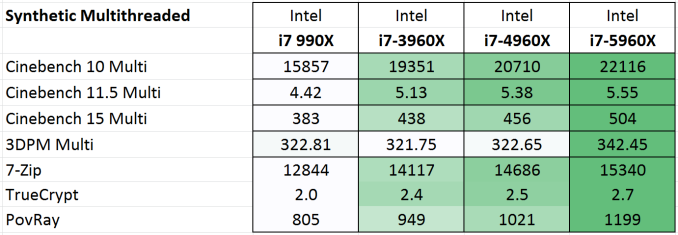

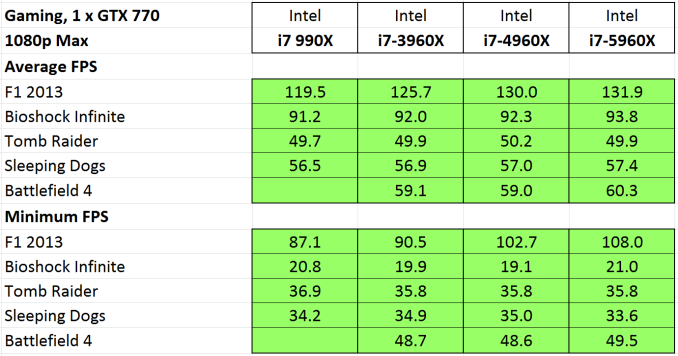
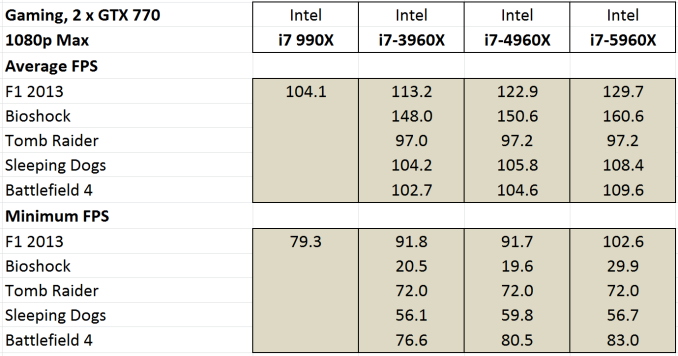
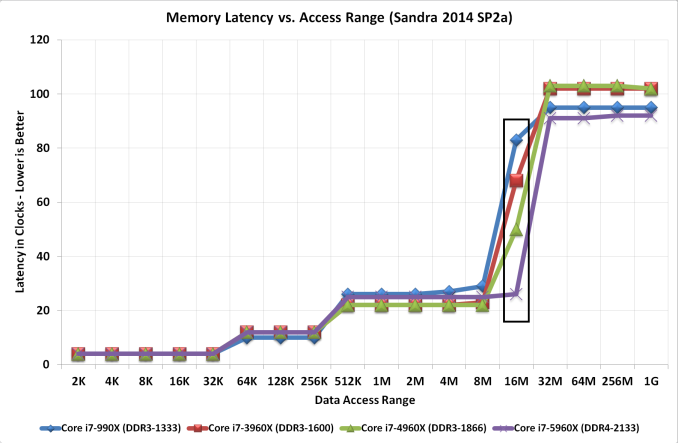








203 Comments
View All Comments
ol1bit - Tuesday, September 2, 2014 - link
You would think since intel seems stuck at a specific design speed for the most part(other than die shrink) that AMD could come up with a better architecture. Maybe there is no better architecture out there?coachingjoy - Tuesday, September 2, 2014 - link
ha, in three years we have 10-15% performance increase.
willis936 - Tuesday, September 2, 2014 - link
Since those parts are nearly identically clocked with a cost per core core being so low you're really getting about a 280% increase in performance per dollar over three years. Compared to other market segments that have practically stalled out everywhere in x86 land yes it is pretty amazing.LemmingOverlord - Tuesday, September 2, 2014 - link
about the gaming benchmarks, core count doesn't really make a difference in most of your chosen games... however there are still a few good CPU-benchmark games that come to mind, Civ V and the Supreme Commander series, to mention a couple. In fact I'd keep an eye out for Planetary Annihilation. It's avalilable this weekend, although I'm pretty sure Uber Entertainment would hand one over just for benchmarking.Gonemad - Tuesday, September 2, 2014 - link
"now the lowest end CPU for the extreme Intel platform". Yep, I'm just using an i7-920, that was exactly at the same spot in its day. Same architecture and memory as the extreme flagship, at a fraction of the cost. Not counting server chips, right?Intel Core i7-5820K, you say eh? Hmm... maybe I should write that down for later... Except I'm not planning anything beyond 1080p, then all of these chips and cards are a bit overkill.
Correction: I want full pedal-to-the-metal at 1080p, perhaps the "average build" should help... right? I appreciate anybody pitching in on the details for a machine to run anything at 1080p (or 1920x1200 actually) at 60 fps, but not more.
azazel1024 - Tuesday, September 2, 2014 - link
I'd like to add what is the most interesting to me is the 5820k. Hexacore cheap (Intel Hexacore, which IMHO is the only kind that matters). I'll likely never have the budget for a $1000 chip and then the system to do it justice.However I currently have an i5-3570 OC to 4GHz. Cost something like $380 for processor and board at the time. For what appears to be around $600 I could now get 50% more cores, hyperthreading and probably be able to reliably OC to a "consevative" 4.2GHz for probably >60% performance improvement for less than half again the cost.
In comparison to moving up to the i7-4770k, which would only cost maybe $50 or so less, with a modest performance improvement (probably only 15-30%).
It does make me VERY interested in Broadwell-E and Skylake-E, as those are the most likely points at which I might be looking at an upgrade. I do wonder if Skylake-E will see entry level Enthusiast Octocore, and maybe even if it'll mean high end mainstream Skylake Hexacore.
That would be an interesting decision if 6 or 8 core processors were not terribly far off in price.
Nfarce - Wednesday, September 3, 2014 - link
"However I currently have an i5-3570 OC to 4GHz. Cost something like $380 for processor and board at the time. For what appears to be around $600 I could now get 50% more cores, hyperthreading and probably be able to reliably OC to a "consevative" 4.2GHz for probably >60% performance improvement for less than half again the cost."Dude, did you forget about the cost of having to buy DDR4 memory modules? That will throw your numbers out the window.
BLOODYHELL - Thursday, September 4, 2014 - link
WHAT DO YOU GUYS THINK FOR LARGE FILE VIDEO EDITING? MMA FIGHTING ETC. ADOBE PREMIRE CS6, VEGAS?BLOODYHELL - Thursday, September 4, 2014 - link
What do you guys think for large video editing MMA FIGHTS, WEDDINGS? Trying to save time editing and rendering videos.naxeem - Thursday, September 4, 2014 - link
Well, since Broadwell is not out yet, I doubt we'll see SkyLake that soon...